Ground robots. From drop systems to unmanned convoys (Part of 3)
By acquiring a six-wheel configuration and the ability to shoot grenades, the HD model of the family robots Nexter Nerva has also acquired nerves for more muscle work
The sizes and masses of medium-sized robots are gradually growing so that they can carry large masses and also can take their first steps towards autonomy of a certain level, although they are still very far from embedding any artificial intelligence.
The champion in the average weight category Dragon Runner 20, developed by QinetiQ for the US Marine Corps. In the photo with installed track extenders
iRobot: In addition to the previously described small 110 FirstLook robot, there are larger robots in the iRobot catalog that have evolved from the original 510 PackBot; Thousands of these robots underwent real service in Iraq and Afghanistan. The Ground Combat Systems (GCS) ground combat system program included a small wearable ground robot that would give infantry units autonomous reconnaissance capabilities in hazardous areas.
A side effect of the closed GCS program was the 310 SUGV system, which has the typical iRobot architecture with tracked chassis and tracked flippers, which ensures good mobility when overcoming stairs and other obstacles. Flippers are removed if a narrower configuration is necessary (reducing the width from 437 to 348 mm). Weight without installed devices is 13,2 kg; The 310 SUGV can reach speeds of up to 10 km / h and overcome obstacles 305 mm in height, its two BB-2557 / U batteries ensure continuous operation of the 1,5 hour, although two BB-2590 / U batteries increase the operating time to six hours. A wide-angle (107 °) front camera chassis with infrared illumination is used to drive the robot. The main sensor for reconnaissance purposes is a color camera mounted on a hand-manipulator for low illumination with x10 magnification (field of view from 48 ° to 5 °). The 2,4 GHz communication channel provides 1000 radius of operation in open areas, the operator uses a wearable controller, which includes Tac-Eye helmet goggles and a popular hand controller (a hardened controller with an 5,6 inch display is available as an option). Model 310 in significant quantities is in service with the American and foreign armed forces.
The XM1216 SUGV is slightly larger and heavier than the previous two models, it weighs 14,5 kg without equipment. It has the most effective long-range intelligence set among the three robots of the family: a color camera with x26 optical zoom and x12 digital camera, as well as a thermal imaging camera with three-step digital zoom. All these robots can be equipped with a robotic arm for the disposal of explosive objects.
Quinetiq: Also in the category of small autonomous ground vehicles there is another system - the multitask Dragon Runner 20 robot manufactured by Qinetiq North America for conducting reconnaissance and demining. This robot was originally designed for the US Marine Corps; its weight is 9,07 kg, the maximum speed is 6,5 km / h, it has day and night cameras in front and behind and only day cameras on the sides.
Intelligence capabilities can be greatly enhanced by the addition of a panoramic camera with zoom, omnidirectional microphone and loudspeaker to provide bi-directional communication. To improve mobility, tracked extension cords plus a rear stabilizer can be installed to overcome the steps.
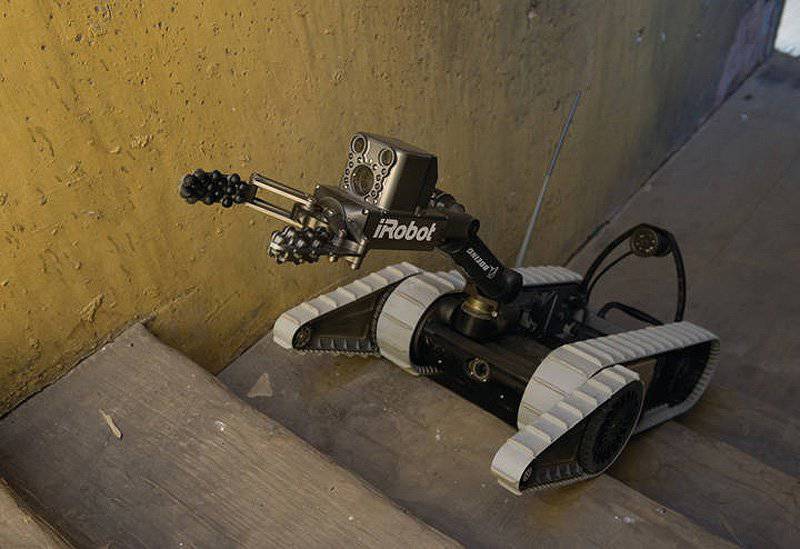
In the middle category, iRobot offers its 310 SUGV robot; in the photo "walks" in steps carrying the device for neutralization of explosive objects
MacroUSA's Scorpion remained abandoned despite the weight of the 9 kg, its payload is equivalent to its own weight
MacroUSA: In the same category, MacroUSA offers the Scorpion 9 kg tracked robot, which can be dropped into the zone of interest thanks to a chassis with high impact resistance made of plastic and reinforcements made of aluminum.
The standard touch kit includes a front-facing day / night color camera with a 185 ° field of view and ± 60 ° tilt angles with infrared and conventional LED lights, a rear color day / night camera and a microphone. Scorpion can reach speeds of 10 km / h and be dropped from a height of one meter. It can transport devices of a mass equal to its own mass, including thermal imagers or chemical sensors, as well as manipulators or devices for disposing of ammunition.
ECA Robotics: Among the lightest robots in the middle category, there is the Cobra Mk2 multi-tasking platform with its own weight of 6,1 kg and a payload of five kilograms offered by the well-known French company ECA Robotics. The company offers various additional devices, such as the CBRN module (chemical, biological, radiological and nuclear weapon) with chemical and radiological sensors and a radiation dosimeter, a module for neutralizing explosive objects with a stand that houses various types of neutralization devices and, of course, a reconnaissance module with a video camera with an 360 ° view. The robot also has a color CCD camera with viewing angles of ± 80 ° in front and a fixed color camera in the back. In addition, there are white and infrared LEDs, a microphone and a speaker for two-way acoustic communication. The Cobra Mk2 4x4 is equipped with low-pressure tires; The lithium-ion battery on the 15 volts guarantees the operating time of the 2,5 hour. The maximum speed is 5 km / h, and the maximum height of obstacles 150 is overcome. The stated working distance in open areas is 250 meters; Two different control units are available, one with an 7 inch screen and one with an 10 inch screen, the design of the joysticks is also different for these units.
The French company ECA developed the robot Cobra Mk2, the first military customer of which was Canada. The robot can be controlled by special control units or commercial systems, such as smartphones.
MTGR (Micro-Tactical Ground Robot) is a multipurpose robot developed by Roboteam, on which large diameter wheels can be mounted
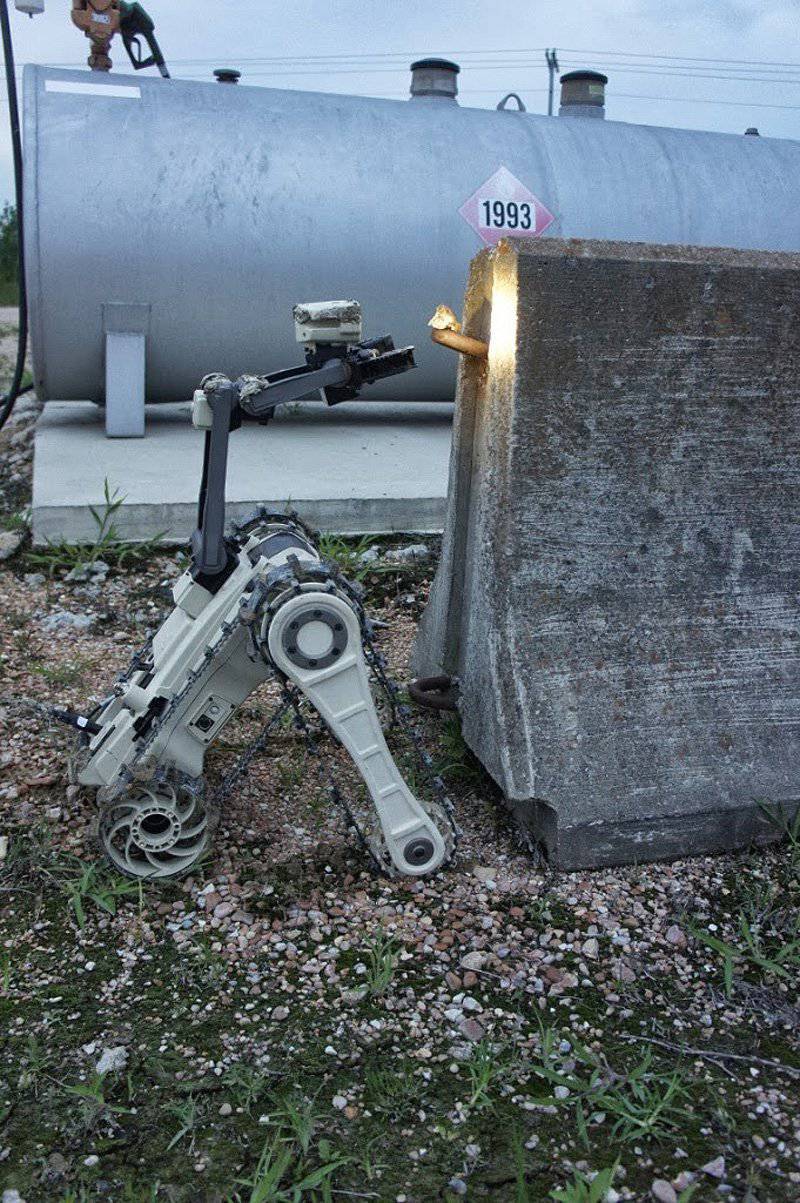
The MTGR robot in the picture demonstrates its ability to pry at night. His articulated tracked system allows him to take a kind of acrobatic poses
One of the latest innovations of ECA Robotics is the ability to use tablets and smartphones based on the android OS to control robots, which reduces the burden on the soldiers, since these devices can be used for various purposes. This was not the only improvement. Now the Cobra Mk2 is equipped with a GPS system that allows the robot to memorize the path and go back to the launch site automatically. Were installed wheels of smaller diameter (less than 20 mm) in order to avoid problems when conducting a robot inspection under the cars; Also now available and a set of tracks to improve patency on complex types of terrain. Canada became the first buyer in the military field of the Cobra Mk2 robot, which ordered 20 robots with an option of 80 more. Canada requested a system with a removable fiber-optic remote control system that allows you to work with the Cobra Mk2 robot at distances up to 1000 meters.
Robo-team: MTGR (Micro-Tactical Ground Robot) was developed by the Israeli company Robo-team as a multitasking robot with the main task of conducting intelligence for the main infantry units. For work in the city, the MTGR has a fully tracked configuration, whereas for off-road driving this configuration is retained, but with the addition of wheels of a much larger diameter, which improves throughput when overcoming dirt, stones and steps.
Obviously, increasing the patency is expensive in terms of mass and size. The standard version weighs 7,3 kg, while the wheeled / tracked version weighs 8,6 kg, the dimensions also increase from 455x368X145 mm to 472x470x165 mm, however, the system remains fully portable. MTGR can start work after being switched on by the operator in less than 60 seconds and reach a speed of 3,2 km / h. The robot can overcome obstacles with a height of 35 cm, slopes of 45 °, steps with a height of 20 cm due to additional tracked flippers. The MTGR robot is equipped with five cameras, the front one is installed in a niche and has an inclination angle of –20 ° / + 90 °, others are installed around the case, providing the operator with a circular view of the 360 °. LED white light is installed only in front, while the illumination in the near infrared region of the spectrum is circular. The MTGR robot can be equipped with a manipulator specially created by Robo-team to transform it into a means of neutralizing explosive objects with the addition of a system. It has four degrees of freedom with two universal joints, one wrist joint and grip. Maximum departure of the 360 manipulator of mm and loading capacity of 5,4 kg. The hand has two cameras: one with the x10 magnification plus the second near-center camera on the grip, both have infrared illumination. Other sensors, such as radiation detectors, gas analyzers, thermal imagers, etc. can be easily integrated with the platform thanks to the picatinny guide. The communication channel of the robot can form a network with other devices, allowing you to increase the range to more than 500 meters in direct line of sight; battery life is from two to four hours. The concept of the nodal network is currently under pressure from new solutions, for example, the inclusion of transceivers in the soldiers' vests, as well as the development of transceivers that the robot can leave behind itself before entering, for example, a sewer pipe or tunnel to ensure reliable communication.
As for complete autonomy, the company Robo-team believe that before it is not less than ten years. However, in order to make MTGR as simple as possible for the operator, the company developed several preset modes for overcoming steps, lifting loads, etc., which significantly reduces human intervention. As a rule, the MTGR robot comes with the Rocu-7 console, which runs on Windows 7, has an 7 inches screen with a resolution of 1024xXNNUMX. The Rocu-600 console has two joysticks, eight hardware buttons and four rocker-type keys; It weighs 7 kg with batteries that allow you to work from three to six hours. The results of tests conducted by the National Institute of Standards and Technology led to an urgent purchase of an unnamed number of MTGR robots by the US command of special operations forces. The system is also being studied by the army for deployment in standard infantry units. MTGR is also in service with the Israeli armed forces, and Robo-team is making a lot of efforts to move the robot around the world.
Nexter: The heavy member of the Nerva family is HD (Heavy Duty) weight 11 kg. It contains numerous elements of lighter robots, but the payload is increased to 10 kg. In the Nerva HD model, the communication channel, the concept of a single click, two speeds and many more elements developed for LG and S models are saved. But this robot can be deployed in three different configurations: 4xXNNUMX, 4x6 and tracked.
Nexter’s eldest Nerva family of HD robots has a dual-slot 6x6 chassis for an onboard hardware module. In the photo on the robot mounted grenade launcher module
In the 4x4 configuration, special wheels with a diameter of 300 mm are installed on the robot, increasing the maneuverability on rough terrain. In addition, to overcome obstacles of increased complexity, two flippers can be installed instead of intermediate wheels. To get the 6x6 configuration, four large wheels are replaced with standard wheels with a diameter of 150 mm, the same as those of the Nerva LG. When installing rubber tracks, the two central wheels become guides and work only as track rollers.
The standard touch kit includes a high-resolution front-facing camera with a 110 ° field of view with visible and infrared light and a rear camera, as well as an omnidirectional microphone. Compared to smaller robots, the HD model has a more complete navigation kit, which includes GPS, odometer, magnetic compass, three gyrometers and three accelerometers, the device is also compatible with the differential GPS system. Such data on the exact location is valuable when working in one of several semi-autonomous modes, for example, it is navigation through route points, autonomous patrols and automatic return to the starting place. Compared to the LG Nerva, the HD model has two slots for standard Nerva functional kits; however, on-board equipment can be connected via a Picatinny rail or a configurable metal plate. The HD model has Ethernet, USB, RS232 connectors, a digital I / O slot and video input. Nexter has developed several kits with a Nerva interface, including a x36 zoom camera on a panoramic head for long-range surveillance, an uncooled thermal imaging camera, an extra battery that doubles the two-hour autonomy, bi-directional intercom, a smoke generator used as an intrusion response or indicator locations and plus several CBRN sensors. Modules for transportation allow you to perform mini-logistic operations, in addition, the company can provide tools for mine clearance.
M-Tecks: Another French company, M-Tecks Robotics, has developed several lightweight dual-purpose ground robots. Symmetric Arthron POD 125A 4x4 can fall without problems from a height of 2,5 meters. Its symmetry is not limited to the physical design, but also expands on its sensors: two color cameras and one night camera and two white-light LED lamps are installed at the front and rear. The capacity of the hot-swap battery on 12,8 volts is enough for one and a half hours of work. Top speed is 15 km / h with standard 170-mm wheels. The wheels may vary for a specific terrain, although in this case, a quick replacement was not foreseen for various reasons, including due to tight pricing policies.
The POD 125A robot communication channel guarantees operation up to 300 meters in open areas and up to 250 meters in the urban jungle. However, the communications architecture was created for mass operations, so the full potential of the M-Tecks Robotics ground robot is achieved when several machines are deployed over a larger area. Up to 127 robots can be used to create a network, each of which works as a network node, which increases range and functional flexibility, especially in urban canyons. The POD 125A robot is equipped with a GPS system. M-Tecks Robotics also did not forget about the pipe inspection robots and left the wire control option for their reconnaissance robots. For POD 125A, wire control is possible at distances up to 30 meters.
The French company M-Tecks Robotics has developed a robot Arthron Pod 125 4x4 with a communication system that allows you to form a network of such devices 127
Arthron R 4075 has an unusual architecture. The modules are connected using universal hinges, which allows the 8 x8 chassis to rotate and bend and significantly increases mobility
In the process of searching for increased mobility on difficult-to-reach surfaces, M-Tecks Robotics developed a larger 9 kg robot. He received the designation R 4075A, its eight-wheeled architecture is rather unusual. The robot consists of four uniaxial modules, which are connected to each other through a universal joint, allowing you to distribute the torque from the main engine all-wheel drive. The multi-hinged design was developed over five years, it significantly improves the turns and bends in the vertical plane and, as a result, improves mobility and overcoming obstacles three times. The main electric motor is installed in one of the medium “cabs”, and the main standard nickel-metal hydride battery on 15 volts with a capacity of 6800 Ah, which guarantees two hours of work, is installed in the other. The two extreme modules have an auxiliary engine, which provide relative movement between them and the neighboring module. Thus, the maneuverability of the multi-link structure is ensured, which allows it to achieve maximum mobility on complex terrain. R 4075 A can cope with obstacles 300 mm in height and 270 mm trenches, as well as overcome slopes up to 100%. Standard wheels have a diameter of 140 mm, in addition, different types of tires can be installed.
Two daytime cameras, the upper one is directed upwards, and the lower one, respectively, downwards, allow to get a combined vertical field of view 160 °. One night camera is pointing horizontally, and two white LED lights give good lighting when needed. The video transmission is provided by the channel at the 2,4 GHz frequency, and the control signals are transmitted via the 869 MHz channel, the transmission distance is 300 meters in open areas and more than 100 meters in urban buildings. Like its smaller brother, the R 4075A robot has the option of wire control at a distance of up to 50 meters. Operating modes include semi-automatic remote control, significantly reducing the operator's load, and even automatic mode. Video stabilization software is available, as well as a dome installation with color or night cameras.
Both POD 125A and R 4075A models are controlled from a 2,5 kg console with an 9 inch screen and a joystick. At present, prototypes of both systems are being tested in the French army and the experience gained in these tests will be integrated into the designs that are still at the development stage.
Robosynthesis: The modular system of this company, described in the section of "light" ground robots, of course, can be used to create larger and heavier robots. An example of this is the multitasking EXTRM platform weighing 9,5 kg, the maximum speed of which varies from 1,5 to 6 km / h depending on the type of propulsion unit. With a total height of just 200 mm (wheel diameter), the robot can overcome obstacles with a height of 450 mm when installing tail rods, handle lateral slopes of 40 ° and slopes up to 50 °, provided there is sufficient grip.
The communication channel can operate at a frequency of 2,4 or 5,8 GHz, providing a range of 1000 meters; The power source is two rechargeable lithium-ion batteries, either BB2590 / U or BB2557 / U, which provide a working time of 12 hours or 3 hours, respectively. The operator controls the robot based on images from a wide-angle camera with 640x480 resolution with fixed focus and infrared illumination. For reconnaissance purposes, there is a panoramic optoelectronic kit, it includes four built-in microcameras with different focal lengths, which gives a step-by-step increase in the field of view from 7,5 ° to 60 °, and the sensitivity of the 0,008 Lux allows you to get a good image even in very low light.
Like all systems from Robosynthesis, the newest version of EXTRM is equipped with several universal connectors with which you can connect equipment of various types. At the Sofex2014 exhibition, the company introduced the Robocube 4x4. It is lighter and smaller than the EXTRM, on top of it there are six universal connectors and two on the sides.
Robosynthesis has developed a modular EXTRM system onto which tail traction can be installed to overcome higher obstacles.
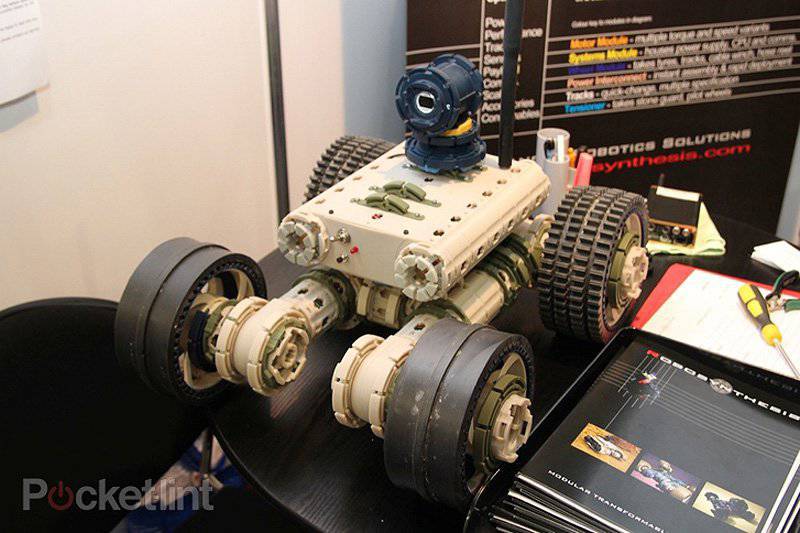
Robocube was featured at the Sofex 2014. This is another medium category robot that has eight connectors for installing additional batteries or devices.
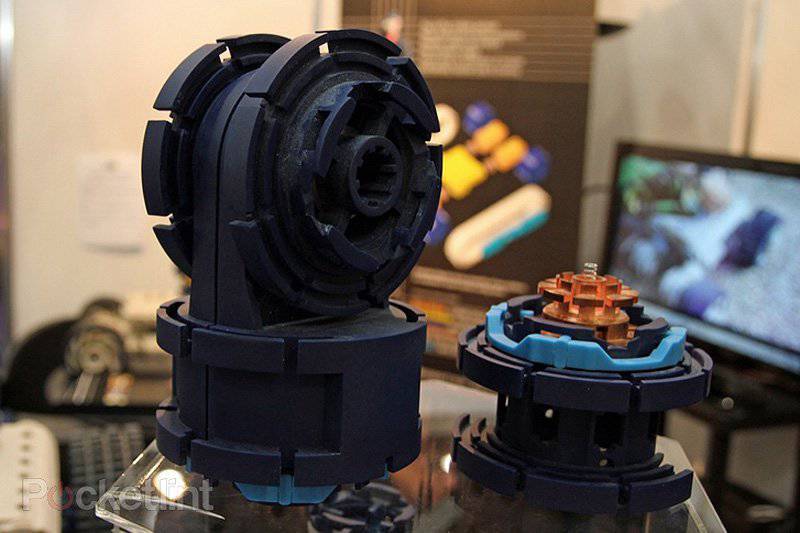
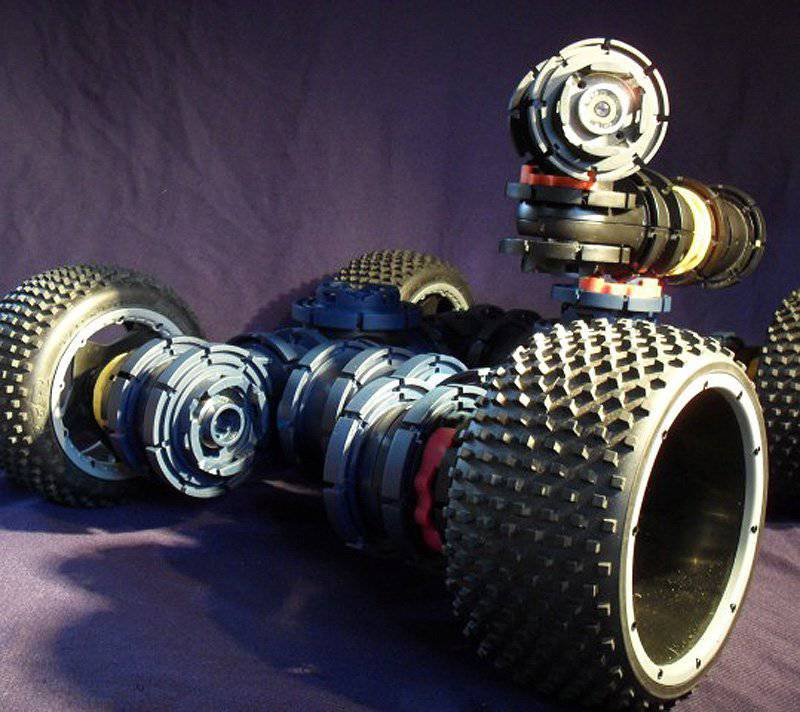
The middle ground of a universal connector developed by Robosynthesis (above), which allows mechanical and electrical connection of equipment with the possibility of data transmission (below is a practical implementation)
Tecdron's Scorpio is relatively heavy for a three-wheeled robot; it was designed with an emphasis on operational reliability
Tecdron: Again, the French company Tecdron has a large assortment of ground robots, from light to heavy. The tactical three-wheeled Scorpio Robot with remote control falls into the middle category with its 5,9 kg. From the very beginning of the program in August 2013, the company gave priority to durability, image quality and range, which led to the creation of a heavier robot compared to robots designed for similar tasks. The Scorpio chassis is made entirely from aircraft-grade aluminum; It is waterproof to a depth of two meters and is coated with an anti-corrosion coating. It can be thrown ten meters without risk of damage to its components. Two electric motors power it, and the rear wheel acts as a stabilizer. The robot can overcome 35 ° slopes and 30 ° side slopes; Rubber wheels with a diameter of 180 mm allow it to have good permeability on difficult surfaces, such as dirt, crushed stone or sand. 12 lithium-ion battery with a 5,8 Ah capacity provides four-hour continuous operation; A second optional battery doubles the running time.
The front is a wide-angle day / night slant camera, an infrared LED illuminates the path, and a microphone is used for audio recording. The image and sound are transmitted via a digital channel to the control station, which consists of a five-inch display, a joystick and several push buttons. In line of sight, the range is 300 meters, and in urban areas and inside buildings, the radius is limited to 100 meters. Scorpio can take up to 8 kg of equipment, although this is not its main purpose. At the moment, he has been tested in the French police for several months. The military had experienced special units and its only drawback was the mass. The smaller Vixen platform is not yet presented to the public, as Tecdron is currently improving it in many ways and a prototype of the new configuration is expected at the end of 2014.
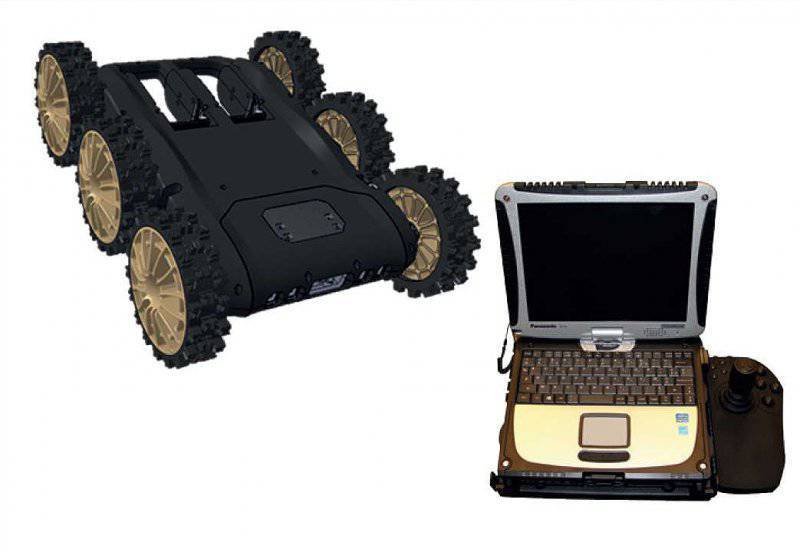
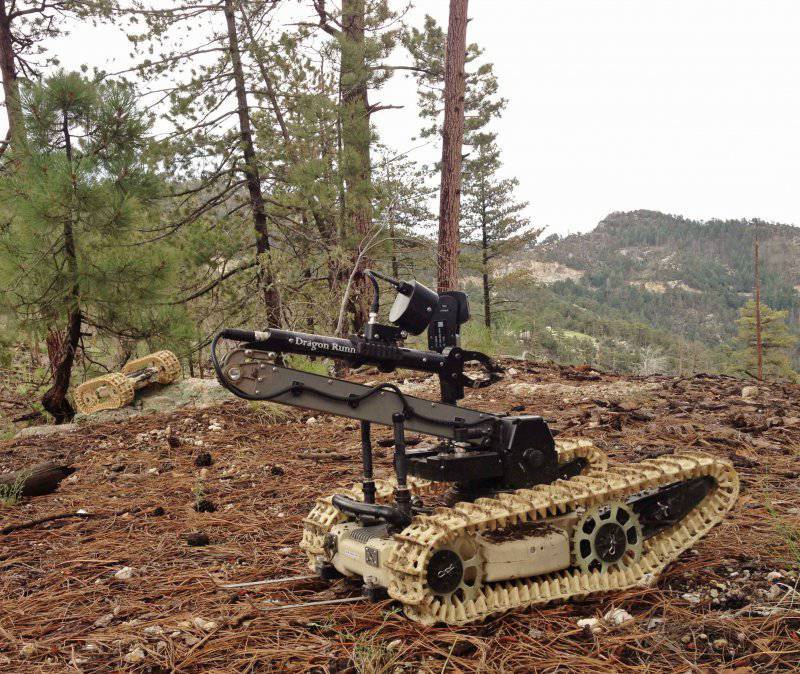
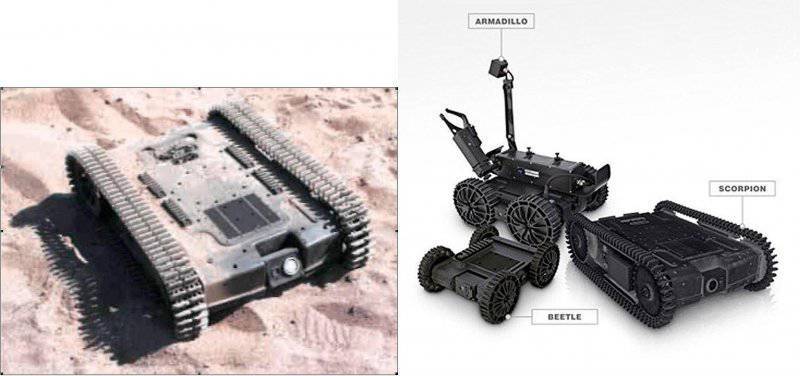
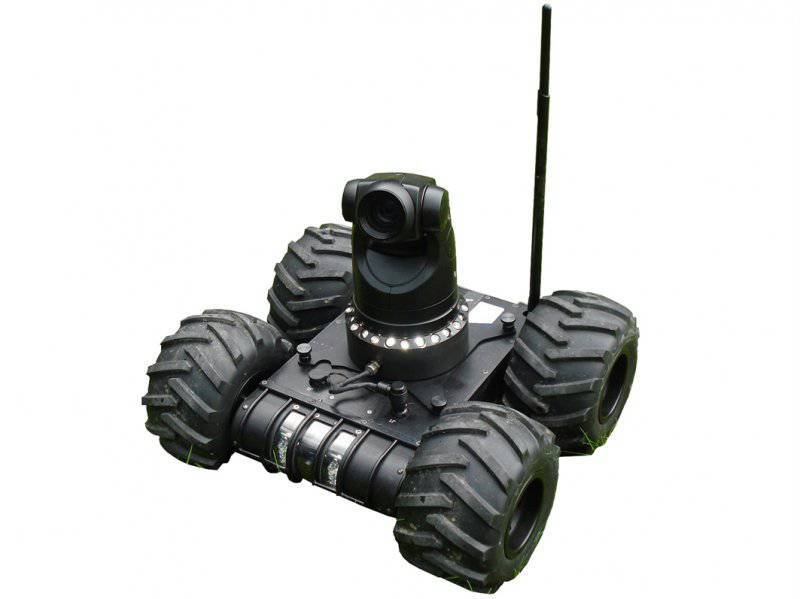
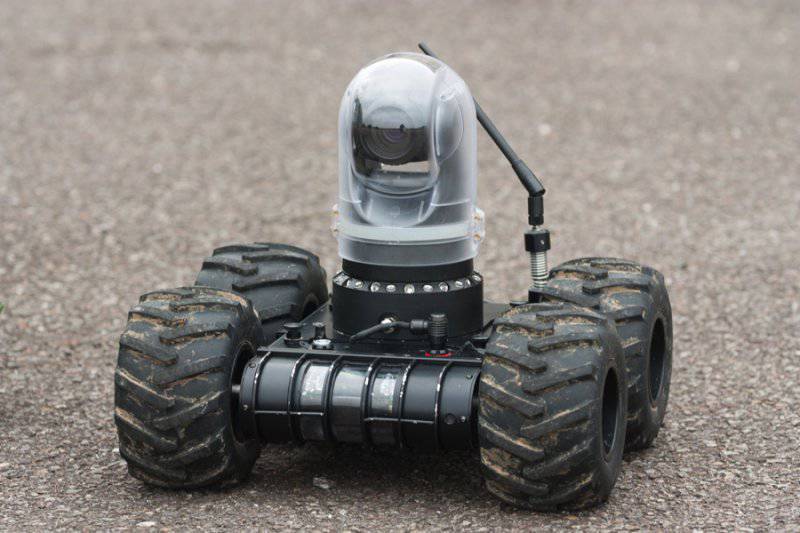
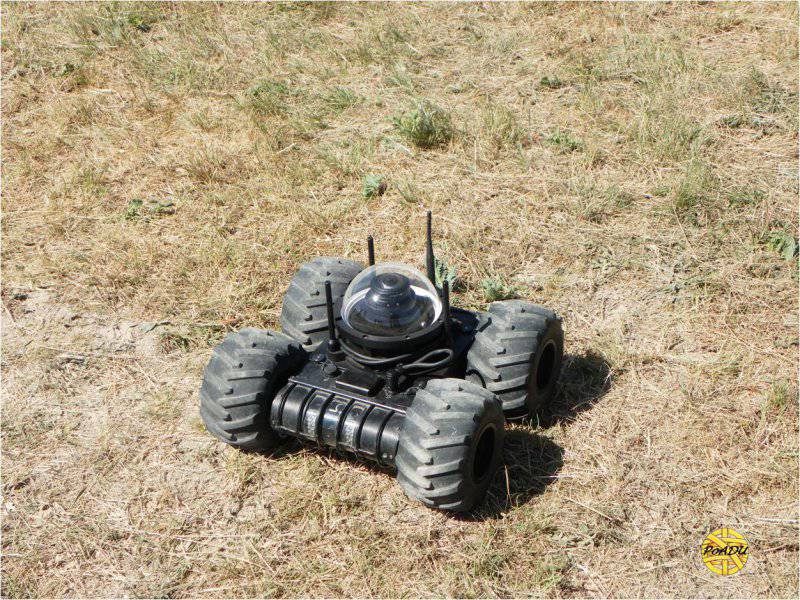
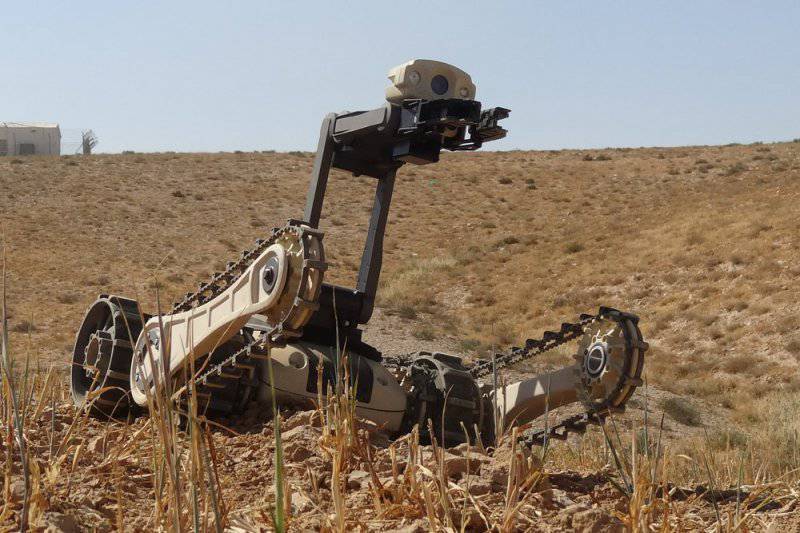
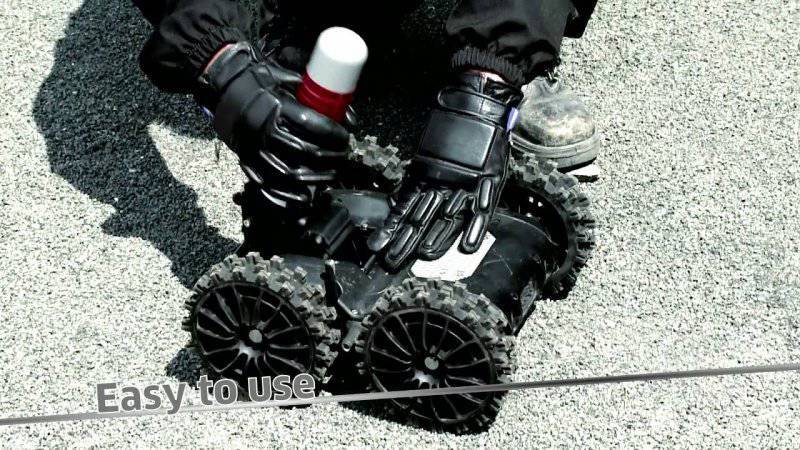
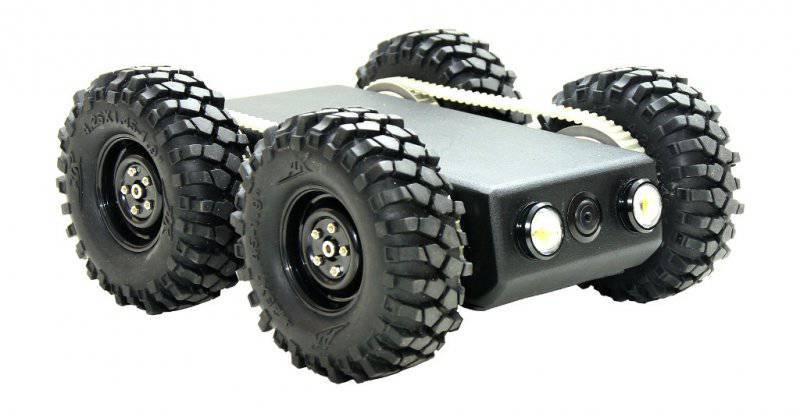
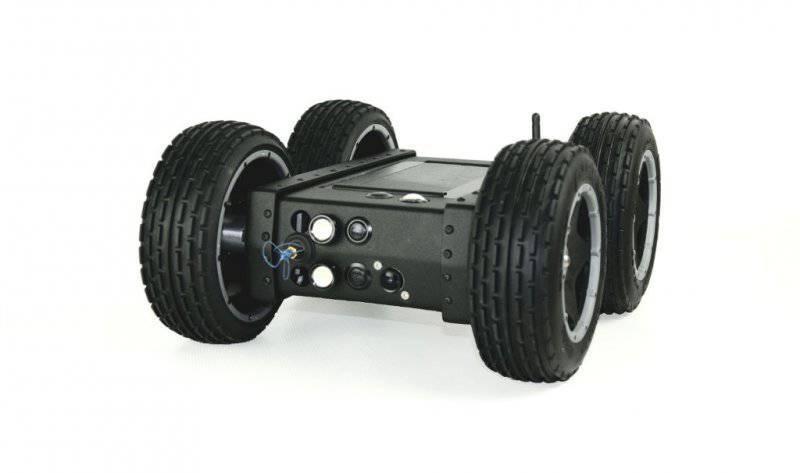
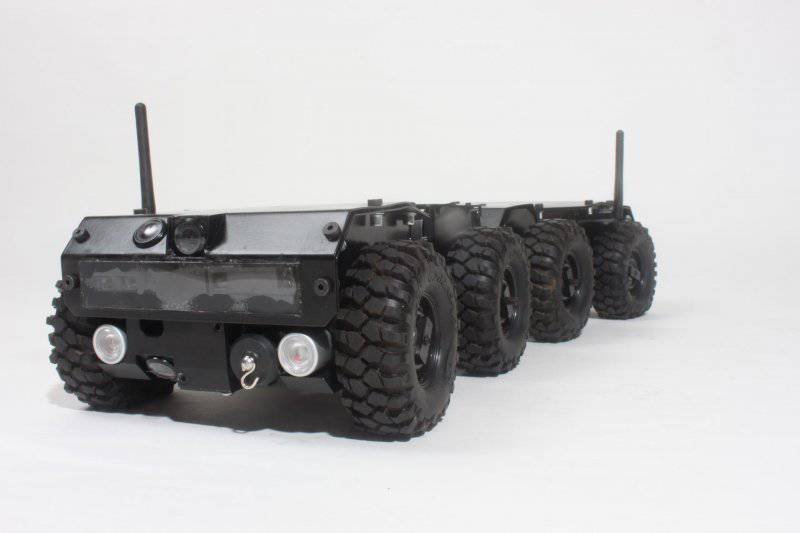
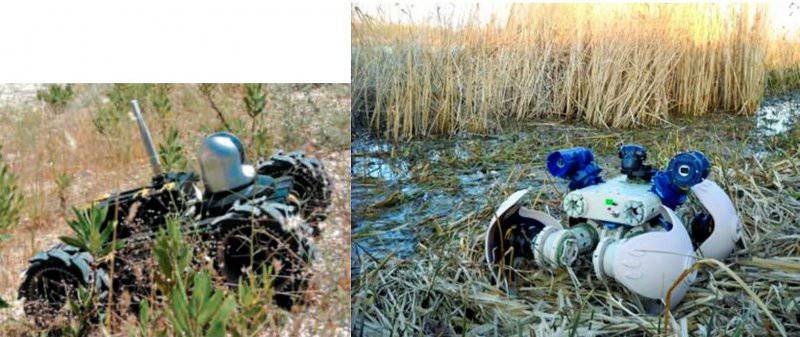
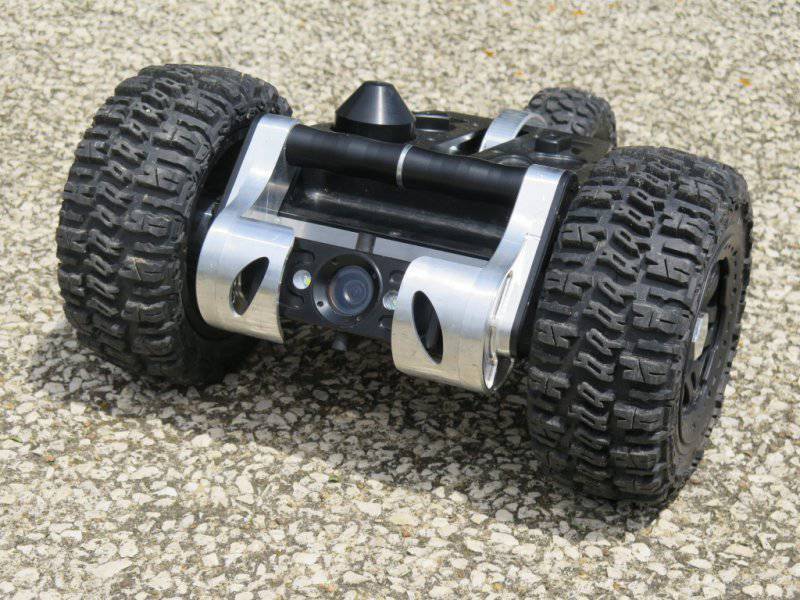
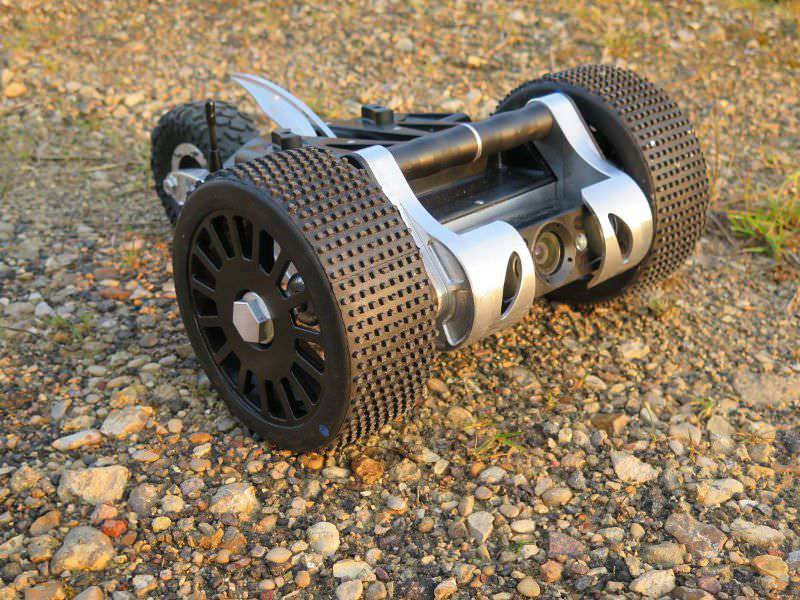
Information